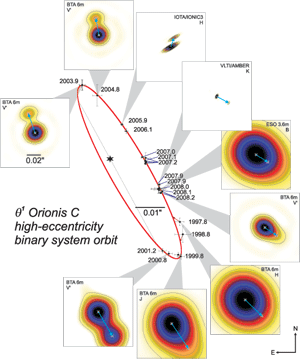- Details
- Published on 01 April 2009
| HIGHLIGHTS: this week in A&A |
Volume 497-1 (April I 2009)
| In section 7. Stellar structure and evolution “Tracing the young massive high-eccentricity binary system Theta 1 Orionis C through periastron passage”, by S. Kraus, G. Weigelt et al., A&A 497, p. 195 Theta 1 Orionis C, the brightest and most massive star in the Orion Trapezium cluster, happens to be a binary with a decade-long orbital period, which makes it an ideal laboratory to determine the fundamental parameters of young hot stars. Kraus et al. used the VLTI/AMBER near-infrared (H- and K-band) long-baseline interferometer to observe the binary during its tightest orbital phases. They combined those measurements with new and literature speckle observations, as well as with radial velocity measurements, to determine the 3D orbit of the system. The resulting mass determination still has sizable errors, but additional measurements over the next few years will fulfill the system's promise as a benchmark for models of massive young stars. A press release based on these results has been issued and is available here. |
|
|
In section 1. Letters to the Editor. Sub-section 7. Stellar structure and evolution |
You can now receive the A&A weekly Highlights by email. To subscribe to the A&A Highlights emailing list, please send an email to This email address is being protected from spambots. You need JavaScript enabled to view it.
© Astronomy & Astrophysics 2009



